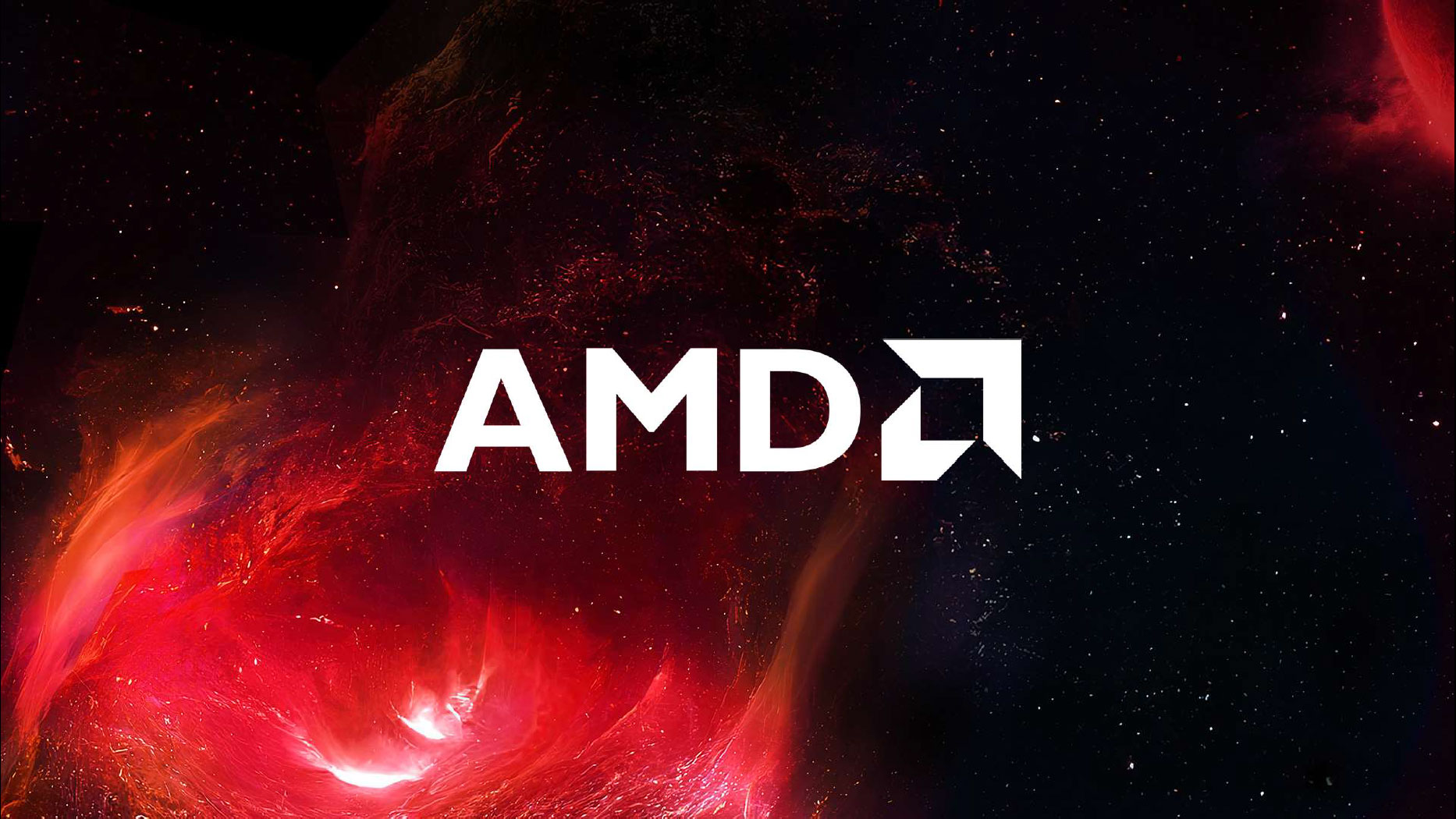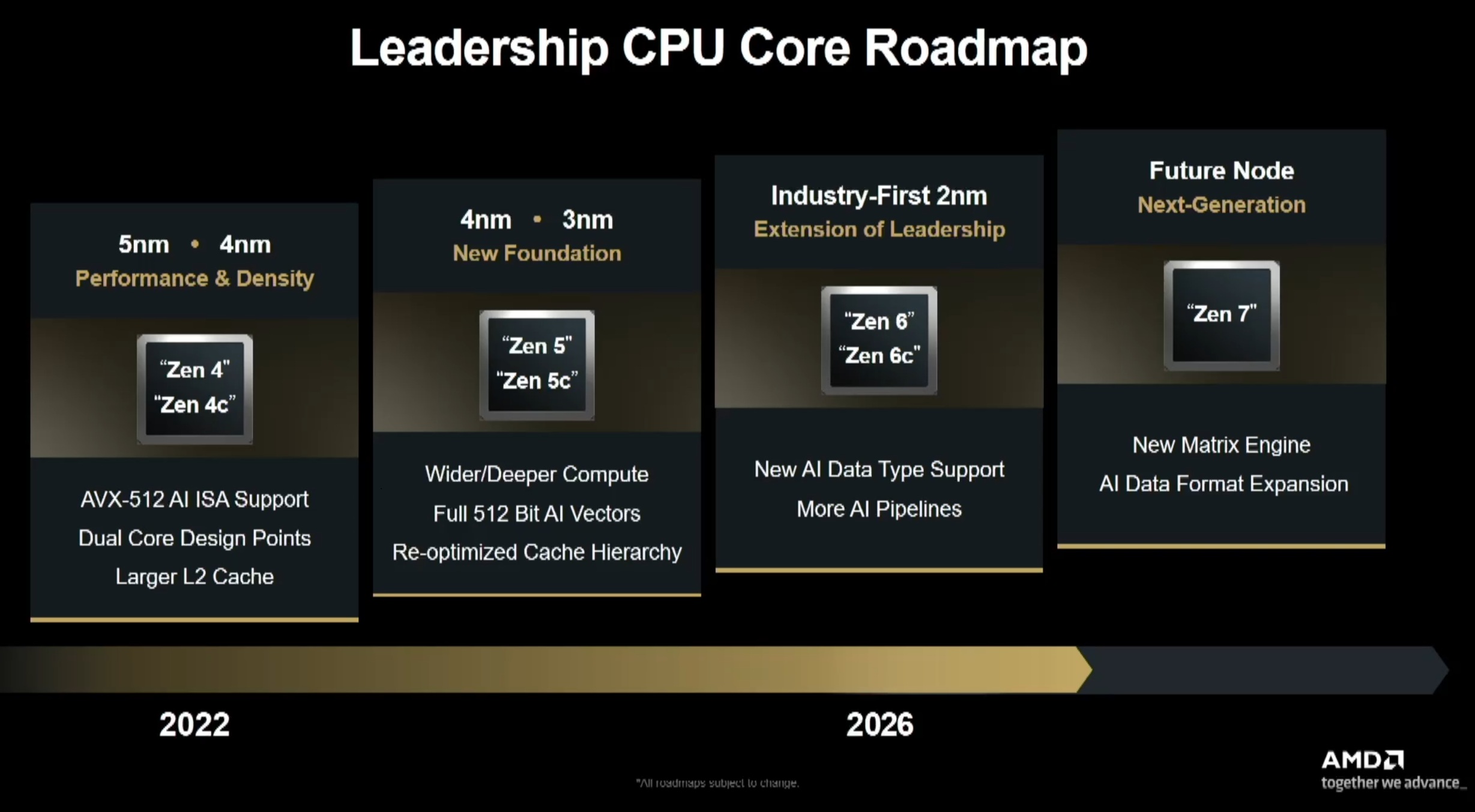AMD reveals new roadmap for its Ryzen CPUs, teasing Zen 7 as the true "next-generation" leap with 2nm — Lineup confirms 2026 release for Zen 6, coming with expanded AI features

AMD has just revealed an updated Zen roadmap for its CPUs at Financial Analyst Day, labeled "Leadership CPU Core Roadmap." While it doesn't delve into details — or even show any new ones — we do get explicit confirmations for a bunch of previously-rumored (albeit obvious) tech. AMD also made Zen 7 official for the first time in a roadmap, teasing a release date beyond 2026. Let's break it all down.
Starting with what's due next: Zen 6. We already knew it was coming next year, which the slide below reinforces, and AMD confirms that Zen 6 will be "industry-first" in leveraging TSCM's flagship 2nm (N2) process nodes. AMD CTO Mark Papermaster highlighted that both Zen 6 and Zen 6C will benefit from IPC improvements, extracting higher performance, while offering more AI features across the Ryzen and EPYC series.

Speaking of, the upcoming EPYC "Venice," Ryzen Desktop "Olympic Ridge," and Ryzen Mobile "Medusa Point" chips will be built on the Zen 6 architecture, with more lineups to follow. AMD's Helios server-rack solutions will also be powered by Zen 6's EPYC Venice, paired with CDNA 5 GPUs using 5th gen Infinity Fabric with 224 GB/s of bandwidth.
Next up is Zen 7, still a couple of years away and fabricated on what AMD's calling a "Future Node." This is AMD's true next-gen product, implying a major shakeup is inbound. Zen 7 will debut a "New Matrix Engine" with even more AI functionality, but that's where the details stop — core configs, cache layout, and so on are at the mercy of leaks.
Current speculation puts Zen 7 at somewhere around 2027-2028 with EPYC "Verano" data center CPUs expected to be its first product. The rest of the roadmap is just a retrospective, boasting how far AMD has come since AM5's launch a little over three years ago, going from 5nm to 2nm in just a span of four years. Since Financial Analyst Day is aimed at investors, there was more focus on artificial intelligence ambitions than thorough technical insight.

Follow Tom's Hardware on Google News, or add us as a preferred source, to get our latest news, analysis, & reviews in your feeds.
Get Tom's Hardware's best news and in-depth reviews, straight to your inbox.

Hassam Nasir is a die-hard hardware enthusiast with years of experience as a tech editor and writer, focusing on detailed CPU comparisons and general hardware news. When he’s not working, you’ll find him bending tubes for his ever-evolving custom water-loop gaming rig or benchmarking the latest CPUs and GPUs just for fun.
-
KraakBal Zen 6 should be 6.5ghz+ apparently (~2.5 node jumps, and GAA transistors), and going to be 12 core ccds, and finally get a new IO die. And zen 7 going to be another 20% overall perf improvement on top of that.Reply
My "new" PC is aging faster, or falling behind faster, than my old one did -
bit_user Reply
I had a chuckle at how many times they worked "AI" into the slide.
The mention of "New Matrix Engine" makes me wonder if they're implementing AMX in Zen 7. -
Makaveli Reply
I'm going abit more conservative on clocks.KraakBal said:Zen 6 should be 6.5ghz+ apparently (~2.5 node jumps, and GAA transistors), and going to be 12 core ccds, and finally get a new IO die. And zen 7 going to be another 20% overall perf improvement on top of that.
My "new" PC is aging faster, or falling behind faster, than my old one did
Base clocks on a 9800X3D is 4.7ghz at 8 cores.
With 12 cores lets say base clocks between 5-5.4Ghz and boost to 6-6.2Ghz. -
bit_user Reply
Node improvements aren't what they used to be. Remember, Intel is already on TSMC N3B, but that hardly gave it supremacy over Zen 5.KraakBal said:Zen 6 should be 6.5ghz+ apparently (~2.5 node jumps, and GAA transistors),
If you need lots of cores, this will be good. I could actually use a 24-core/48-thread CPU at work. At home, I'm doing fine with 6. Would consider stepping up to 8 or 10, if not too expensive.KraakBal said:going to be 12 core ccds,
I need this + the new die-to-die interconnect they trialed in Ryzen AI Max (Strix Halo). The idle and single-thread power consumption numbers of that chiplet-based CPU are much closer to their monolithic APUs. Sign me up!KraakBal said:and finally get a new IO die.
CUDIMM memory support will also be nice to have. More bandwidth will be especially valuable in keeping up to 24 cores fed!
Nobody knows this, and don't trust the rumors. Zen 5 was rumored to be a huge IPC speedup and it just wasn't. Not that it's a bad CPU, but it just goes to show you cannot trust the rumor mill. I don't even pay attention to anything not from a really credible leak, nor this far in advance.KraakBal said:zen 7 going to be another 20% overall perf improvement on top of that. -
-Fran- Reply
Depends on the power they want to target... Or the "TDP".Makaveli said:I'm going abit more conservative on clocks.
Base clocks on a 9800X3D is 4.7ghz at 8 cores.
With 12 cores lets say base clocks between 5-5.4Ghz and boost to 6-6.2Ghz.
My 9950X3D happily goes to 5.6Ghz all core under load. Yes, that is all 16 cores at 5.6Ghz under full load (CB24, Prime and OCCT) with a -30 all-core voltage reduction.
The power draw is around 260W, but it's reasonable for all 16 cores at 100%.
I can absolutely see them tweaking transistors for higher clocks and not caring too much about power leaving it to silicon lotery on the consumer side and having 6.5Ghz boost easily. The node jump is quite substantial and it'll show. They're also changing some internal connectivity for the dies, so it'll potentially ease the power balance within the SoC so they can get more clocks out of it. So: clock tweaking, almost a 2-gen equivalent node jump should be around 500Mhz to 1Ghz clock boost for single looking at past jumps and extrapolating a bit.
Regards. -
SomeoneElse23 Reply
I have a similar experience with my 9950X (non 3d). It's amazing how fast this thing runs. (I upgraded from a 5950X...)-Fran- said:My 9950X3D happily goes to 5.6Ghz all core under load. Yes, that is all 16 cores at 5.6Ghz under full load (CB24, Prime and OCCT) with a -30 all-core voltage reduction.
-
bit_user Reply
Wow, impressive!-Fran- said:Depends on the power they want to target... Or the "TDP".
My 9950X3D happily goes to 5.6Ghz all core under load. Yes, that is all 16 cores at 5.6Ghz under full load (CB24, Prime and OCCT) with a -30 all-core voltage reduction.
The power draw is around 260W, but it's reasonable for all 16 cores at 100%.
Eh, I'm just not sure clock speed is where it's at, these days. These chiplets are really made for servers, which don't achieve clocks anywhere near as high as the desktop CPUs. So, they don't really have incentives to chase clock speeds too aggressively. I'd guess more along the lines of a 500 MHz increase.-Fran- said:I can absolutely see them tweaking transistors for higher clocks and not caring too much about power leaving it to silicon lotery on the consumer side and having 6.5Ghz boost easily. The node jump is quite substantial and it'll show. They're also changing some internal connectivity for the dies, so it'll potentially ease the power balance within the SoC so they can get more clocks out of it. So: clock tweaking, almost a 2-gen equivalent node jump should be around 500Mhz to 1Ghz clock boost for single looking at past jumps and extrapolating a bit.